A couple of weeks ago, Porter Hole Sink went active and drained a large portion of Lake Jackson. The draw down attracted crowds- both in person and online. People were captivated by this well known waterway undergoing a dramatic- yet naturally and regularly occurring- geological event.
It’s a reminder of what our Leon County lakes mean to the area. We enjoy them for their own sake- fishing, kayaking, and boating in them, or hiking and bird watching around them. But they are a part of a larger whole, waterways connected above and below ground.
Our four largest natural lakes- Jackson, Iamonia, Miccosukee, and Lafayette- contain large sinkholes that periodically drain into the Floridan Aquifer, the source of our drinking water and springs. Three of those lakes have been shown to send water to Wakulla Spring. These and other lakes in our area contain smaller connections to the aquifer as well, and many are connected to rivers and other lakes by waterways aboveground.
Each of our lakes is an ecosystem unto itself, and also an interconnected component of our north Florida eco-region. With that in mind, we look at the health of our lakes. Leon County’s Water Quality Monitoring Program, led by Water Resource Scientist Johnny Richardson, samples area waterways multiple times a year. The following is data culled from their reports. We include a link to each lake’s individual report under its entry in this post.
Measuring Water Quality in Lakes- What do all the numbers mean?
Nutrients: Leon County checks for chlorophyll-a, nitrogen, and phosphorous. These nutrients are naturally occurring, but an excess can impair water quality and spur toxic algae (cyanobacteria) blooms. Non-naturally occurring nutrients can come from synthetic fertilizers and other human activities.
The ideal nutrient level for each lake depends on whether it is clear or dark, and if it’s clear, on its alkalinity. Leon County uses Florida Department of Environmental Protection thresholds for nutrients based on these qualities.
When a lake exceeds a nutrient threshold, we’ll label the results in red.
Fish Safety: The Florida Department of Health regularly updates its Fish Consumption Advisories, which lists food safety information for state waterways. DOH recommends limits for fish containing a certain amount of mercury and other contaminants; mercury level varies by species and waterway.
1. Major Sinkhole Lakes of the Red Hills
Lake Jackson
Nutrients (FDEP Criteria for Clear Water, Low Alkalinity Lake)
Chlorophyll-a threshold: 6.0 micrograms (μg)/ Liter (11.4 in 2019)
Total nitrogen threshold: .51-.93 milligrams (mg)/L (.54 in 2019)
Total phosphorous threshold: .01-.03 mg/L (.03 in 2019)
Per FDEP requirements, a lake cannot exceed any of these three criteria more than once in a three year period. Lake Jackson has exceeded chlorophyll-a in four of the last five years, total nitrogen in three of five, and total phosphorus in four of five.
The 2019 measurement for chlorophyll-a is the highest ever recorded for Lake Jackson. According to Leon County’s report for the lake, the reason might be heavy herbicide spraying aimed at reducing invasive hydrilla. Where the herbicide was sprayed on the south side of the lake, native floating plants were “no longer present in the numbers needed to ‘shade out’ phytoplankton, allowing phytoplankton numbers to increase and contributing to the elevated chlorophyll-a numbers.”
Lake Jackson Fish Advisory
The Florida Department of Health recommends limits for fish consumption based on mercury levels in Lake Jackson:
- Black crappie, bluegill, chain pickerel, redear sunfish, and warmouth: two per week
- Largemouth bass: two per week, once per month for pregnant women and young children.

Lake Jackson at a Glance
- Lake Jackson covers around 4,254 acres, and drains a basin of 27,096 acres.
- A prairie lake with two major sinkholes, Porter Hole Sink and Lime Sink. Like the other three major sinkhole lakes in Tallahassee, it dries down periodically, most recently in 2021 (pictured here).
- The only one of the Red Hills sinkhole lakes never to have had its major sinkholes dammed.
- In 2018, McGlynn Laboratories, Inc. found a connection between Porter Sink and Wakulla Spring using a dye trace.
Read the full Leon County report for Lake Jackson.
Lake Iamonia
Nutrients (FDEP Criteria for Dark Water Lake)
Chlorophyll-a threshold: 20 micrograms (μg)/ Liter (6.2 in 2019)
Total nitrogen threshold: 1.27-2.23 milligrams (mg)/L (.50 in 2019)
Total phosphorous threshold: .05-0.16 mg/L (.02 in 2019)
Metals
Two of Lake Iamonia’s sampling stations showed elevated copper levels in 2019. The report theorizes this is from copper-based algaecides used in the lake.
Lake Iamonia Fish Advisory
The Florida Department of Health recommends limits for fish consumption based on mercury levels in Lake Iamonia:
- Black crappie, bluegill and redear sunfish: Twice a week, and once a week for pregnant women and young children.
- Brown bullhead catfish: two per week.
- Largemouth bass: Once per week, once per month for pregnant women and young children.
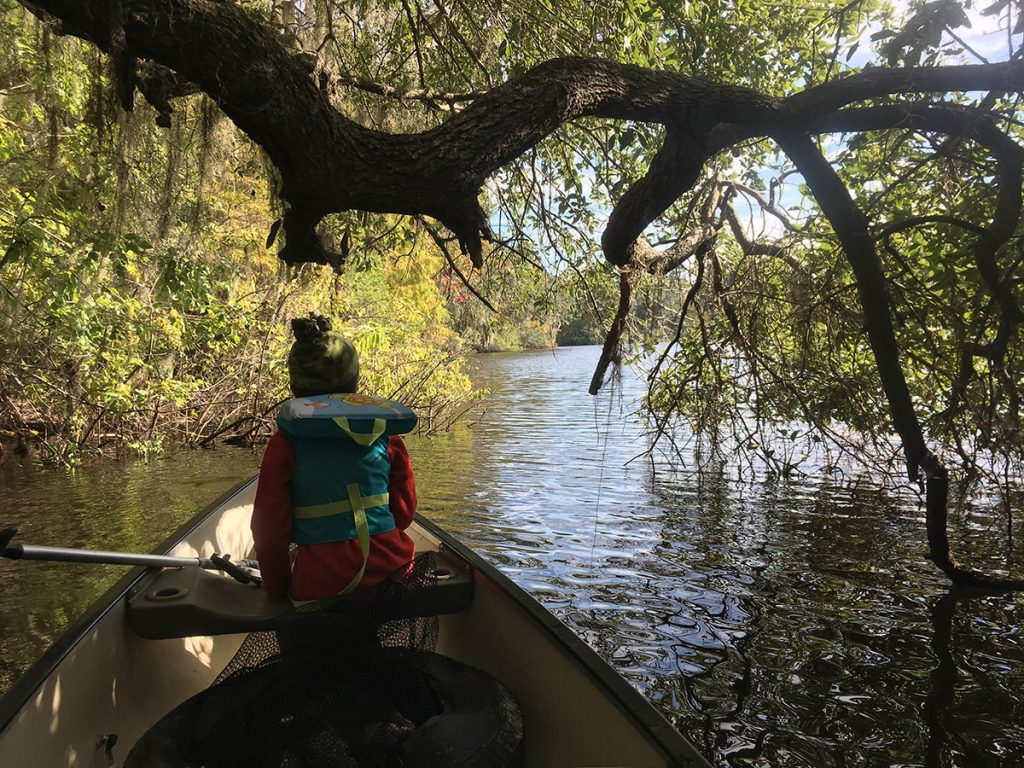
Lake Iamonia at a Glance
- Lake Iamonia covers around 5,554 acres, and drains a basin of 66,727 acres.
- A prairie lake with a sinkhole, subject to periodic dry down events. Lake Iamonia also receives water from the Ochlockonee River when that river floods.
- An earthen dam was built around the 20 acre sinkhole basin in 1939, to prevent draw downs. The gates of the dam were left permanently open starting in 1980, and were removed altogether in 2007.
- In 2018, McGlynn Laboratories, Inc. found a connection between Iamonia Sink and Wakulla Spring using a dye trace.
- Browse previous WFSU Ecology Blog stories about Lake Iamonia.
Read the full Leon County water quality report for Lake Iamonia.
Lake Miccosukee
Nutrients (FDEP Criteria for Dark Water Lake)
Chlorophyll-a threshold: 20 micrograms (μg)/ Liter (7.7 in 2019)
Total nitrogen threshold: 1.27-2.23 milligrams (mg)/L (.63 in 2019)
Total phosphorous threshold: .05-0.16 mg/L (.03 in 2019)
Lake Miccosukee Fish Advisory
The Florida Department of Health recommends limits for fish consumption based on mercury levels in Lake Miccosukee:
- Bluegill: Twice a week.
- Largemouth bass: Twice per week, once per month for pregnant women and young children.
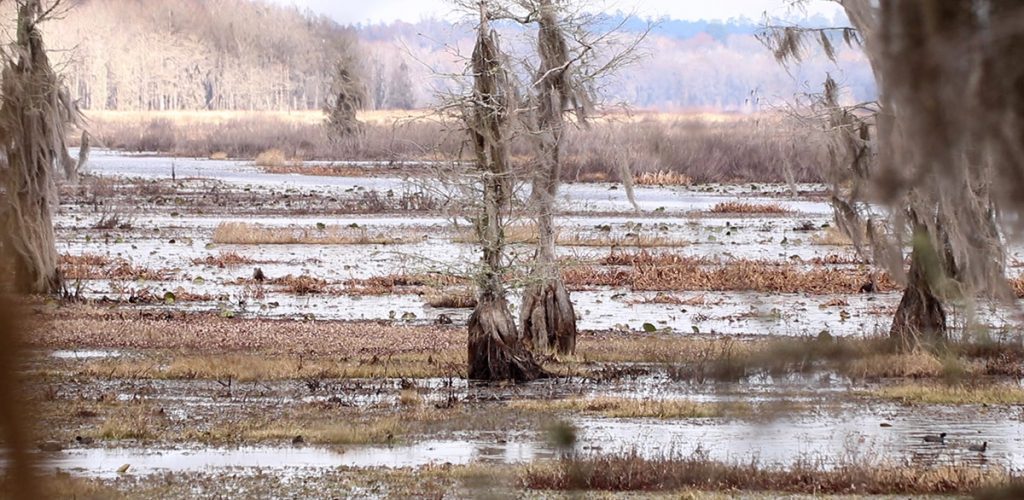
Lake Miccosukee at a Glance
- Lake Miccosukee covers around 6,257 acres, and drains a basin of 147,861 acres.
- A prairie lake with a sinkhole, subject to periodic dry down events.
- The northern sinkhole was dammed in 1954, and the control structure is opened at times during droughts, to draw down the lake.
- In 2018, we visited two smaller sinkholes in the southwest of the lake, after they had gone active. These do not drain the lake as a whole.
Read the full Leon County water quality report for Lake Miccosukee.
Lake Lafayette
The fourth of our large prairie lakes is the most altered by humans. Those of us who enjoy walking or biking on the Lafayette Heritage Trail have enjoyed views from earthen dams that split the lake in four. Those dams have altered the hydrology of the lake, and caused ecological problems in each of the smaller water bodies.
Lafayette Sink is in Upper Lake Lafayette. When it draws down, Piney Z. Lake, Lower Lake Lafayette, and Alford Arm do not.
As you can see in the map above, Lower Lake Lafayette and Alford Arm are heavily vegetated. According to Leon County, “although pockets of open water are scattered throughout Lower Lake Lafayette, the ‘lake’ functions more like a wetland.” Because it doesn’t draw down, what open water there is can become choked with floating islands of vegetation called tussocks. Within the last few years, Florida Fish and Wildlife and the County brought in heavy machinery to reestablish areas of open water.
Piney Z. Lake, on the other hand, has too little vegetation. The County’s report points to the use of herbicides and the introduction of grass eating carp. Because of the amount of runoff entering the lake, and the lack of vegetation to filter nutrients from that runoff, Piney Z. suffers from frequent toxic algae blooms.
Upper Lake Lafayette also receives runoff and suffers from toxic algae blooms. In 2018, a dye trace showed that water draining out of Lafayette Sink emerges from Wakulla Spring a few weeks later.
We’ll look at each “sub”-lake individually.
Upper Lake Lafayette
Nutrients (FDEP Criteria for Clear Water, High Alkalinity Lake)
Chlorophyll-a threshold: 20.0 micrograms (μg)/ Liter (48.2 in 2019)
Total nitrogen threshold: 1.05-1.91 milligrams (mg)/L (1.55 in 2019)
Total phosphorous threshold: .03-.09 mg/L (.14 in 2019)
Per FDEP requirements, a lake cannot exceed any of these three criteria more than once in a three year period. Upper Lake Lafayette has exceeded chlorophyll-a in three of the last five years, total nitrogen in two of five, and total phosphorus in three of five. However, low water levels in the lake prevented sampling in 2016 and 2018.
Fish Kills
Florida Department of Health does not list any fish advisories for Upper Lake Lafayette. However, the lake does have a history of fish kills. The report points to fluctuating water levels and runoff as affecting the amount of oxygen available to fish. A September 2019 fish kill, for instance, occurred when the water was down to the level of the sinkhole, and nutrients from runoff were concentrated in small area.
Piney Z. Lake
Nutrients (FDEP Criteria for Clear Water, Low Alkalinity Lake)
Chlorophyll-a threshold: 6.0 micrograms (μg)/ Liter (23.5 in 2019)
Total nitrogen threshold: .51-.93 milligrams (mg)/L (.87 in 2019)
Total phosphorous threshold: .01-.03 mg/L (.05 in 2019)
Piney Z. Lake has exceeded state limits for each category in almost every year since the county started sampling.
Piney Z. Lake Fish Advisory
The Florida Department of Health recommends limits for fish consumption based on mercury levels in Piney Z. Lake:
- Bluegill and brown bullhead catfish: Twice a week, and once a week for pregnant women and young children.
- Redear sunfish and warmouth: two per week.
- Largemouth bass: Once per week, once per month for pregnant women and young children.
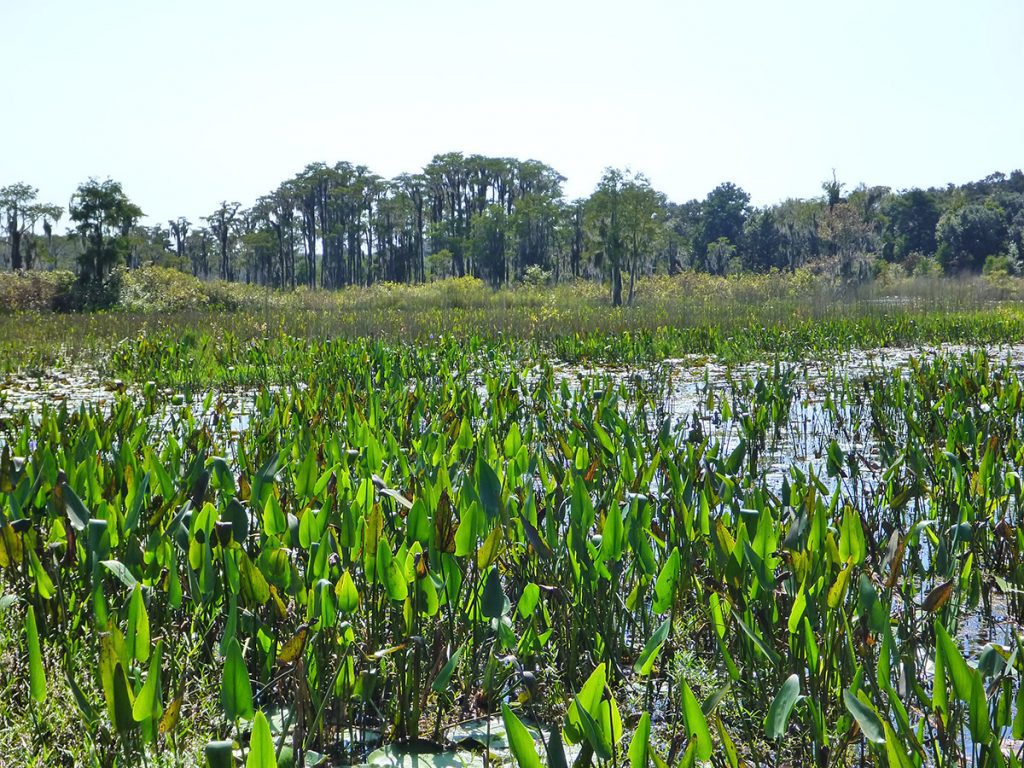
Lower Lake Lafayette
Nutrients (FDEP Criteria for Dark Water Lake)
Due to low water conditions, Lower Lake Lafayette was not sampled in 2018 or 2019. The lake annually meets state water quality criteria.
Chlorophyll-a threshold: 20 micrograms (μg)/ Liter (5.4 in 2017)
Total nitrogen threshold: 1.27-2.23 milligrams (mg)/L (.64 in 2017)
Total phosphorous threshold: .05-0.16 mg/L (.02 in 2017)
There is no Florida DOH fish advisory for Lower Lake Lafayette
Alford Arm
Dense vegetation and low water levels have made Alford Arm difficult to sample. Because of this, the County stopped sampling here in 2015.

Lake Lafayette at a Glance
- Upper Lake Lafayette covers about 354 acres, and drains a basin of 14,792 acres.
- Piney Z. Lake covers about 228 acres, and drains a basin of 691 acres.
- Lower Lake Lafayette covers about 1,006 acres, and drains a basin of 36,966 acres.
- Alford Arm covers 371 acres and drains a basin of 30,116 acres.
- Lower Lake Lafayette is home to a wood stork rookery.
- Per the report: “In 1997, Lake Piney Z was drawn down and organic matter was scraped from the bottom and used to construct fishing fingers extending north from the southern bank.”
- In 2018, McGlynn Laboratories, Inc. found a connection between sinks in Upper Lake Lafayette and Wakulla Spring using a dye trace.
- Browse previous stories about Lake Lafayette.
Read the full Leon County water quality report for Lake Lafayette.
2. Other Lakes of the Red Hills
Lake Talquin
Lake Talquin is Tallahassee’s largest lake, but it is not a natural water body. It was formed in 1929 when the Jackson Bluff Dam was built on the Ochlockonee River, where it meets Highway 20.
Nutrients (FDEP Criteria for Dark Water Lake)
Chlorophyll-a threshold: 20 micrograms (μg)/ Liter (25 in 2019)
Total nitrogen threshold: 1.27-2.23 milligrams (mg)/L (.70 in 2019)
Total phosphorous threshold: .05-0.16 mg/L (.07 in 2019)
Lake Talquin has not met state criteria for Chlorophyll-a and total phosphorus threshold in four of the last five years.
Lake Talquin Fish Advisory
The Florida Department of Health recommends limits for fish consumption based on mercury levels in Lake Talquin:
- Black crappie, bluegill, brown bullhead catfish, channel catfish, redbreast, redear sunfish and spotted bullhead catfish: two per week.
- Largemouth bass: Once per week, once per month for pregnant women and young children.
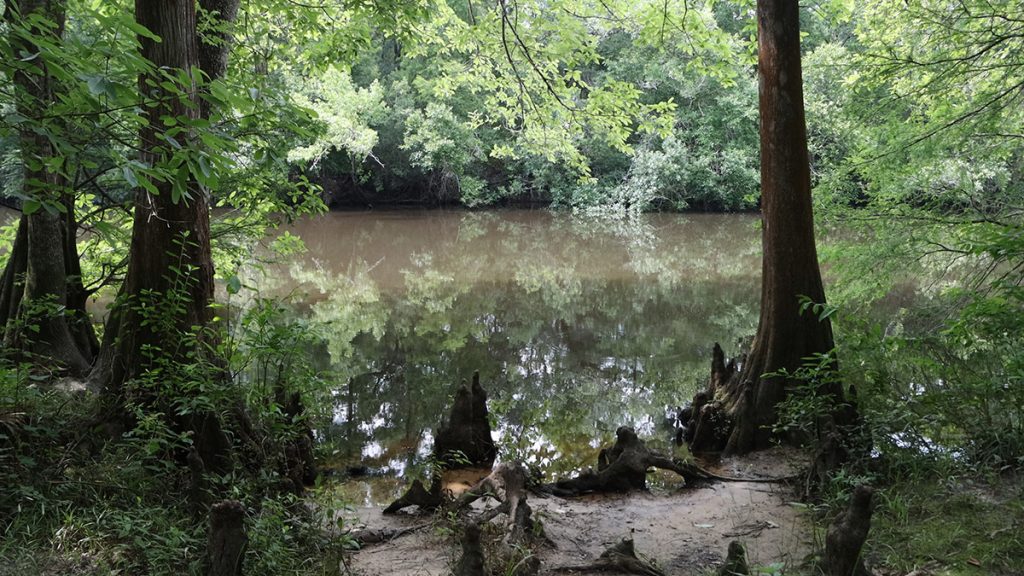
Lake Talquin at a Glance
- Lake Talquin covers 7,782 acres and is created by the Ochlockonee River, which drains a 1,019,525 acre basin in Florida and Georgia.
- The Ochlockonee River starts near Macon, Georgia, and runs 206 miles from there to Ochlockonee Bay in Florida.
Read the full Leon County water quality report for Lake Talquin.
Lake Hall
Nutrients (FDEP Criteria for Clear Water, Low Alkalinity Lake)
Chlorophyll-a threshold: 6.0 micrograms (μg)/ Liter (3.2 in 2019)
Total nitrogen threshold: .51-.93 milligrams (mg)/L (.26 in 2019)
Total phosphorous threshold: .01-.03 mg/L (.01 in 2019)
There is no Florida DOH fish advisory for Lake Hall
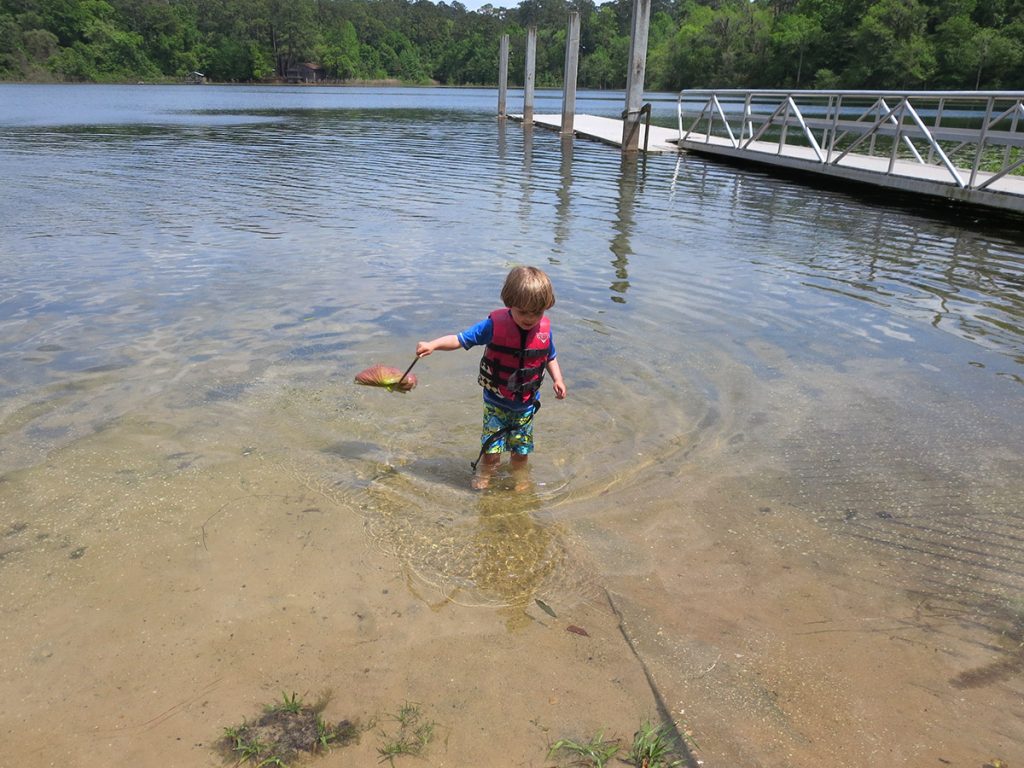
Lake Hall at a Glance
- Lake Hall covers 182 acres and drains a basin of 773 acres.
- The lake is a part of Alfred B. Maclay Gardens State Park.
Read the full Leon County water quality report for Lake Hall.
Bradford Brook Chain of Lakes
Lake Bradford, Lake Hiawatha, and Lake Cascade are connected by Bradford Brook. Lake Cascade flows into Lake Hiawatha via a culvert under Capital Circle, and lake Hiawatha flows into Lake Bradford. When water is high, the connection between Bradford and Hiawatha is navigable by boat, as pictured above.
Lake Bradford
Nutrients (FDEP Criteria for Dark Water Lake)
Chlorophyll-a threshold: 20 micrograms (μg)/ Liter (8 in 2019)
Total nitrogen threshold: 1.27-2.23 milligrams (mg)/L (.50 in 2019)
Total phosphorous threshold: .05-0.16 mg/L (.02 in 2019)
Metals
Lake Bradford has regularly been found to have elevated lead levels. The county believes this is caused by airline fuel from nearby Tallahassee Airport, and/ or is residual from a bygone shooting range located by Tallahassee Community College.
Lake Bradford Lake Fish Advisory
The Florida Department of Health recommends limits for fish consumption based on mercury levels in Lake Bradford:
- Bluegill: Twice a week, and once a month for pregnant women and young children.
- Redear sunfish: two per week, and once a week for pregnant women and young children.
- Largemouth bass: Once per month, and a recommendation of DO NOT EAT for pregnant women and small children.
Lake Hiawatha
Nutrients (FDEP Criteria for Dark Water Lake)
Chlorophyll-a threshold: 20 micrograms (μg)/ Liter (7.7 in 2019)
Total nitrogen threshold: 1.27-2.23 milligrams (mg)/L (.52 in 2019)
Total phosphorous threshold: .05-0.16 mg/L (.02 in 2019)
Metals
Leon County found elevated copper levels in the first quarter of 2019. The source of the copper is unknown.
Lake Cascade
Nutrients (FDEP Criteria for Dark Water Lake)
Chlorophyll-a threshold: 20 micrograms (μg)/ Liter (4.8 in 2017)
Total nitrogen threshold: 1.27-2.23 milligrams (mg)/L (.83 in 2017)
Total phosphorous threshold: .05-0.16 mg/L (.01 in 2017)
Water levels were too low to sample in 2018-2019.
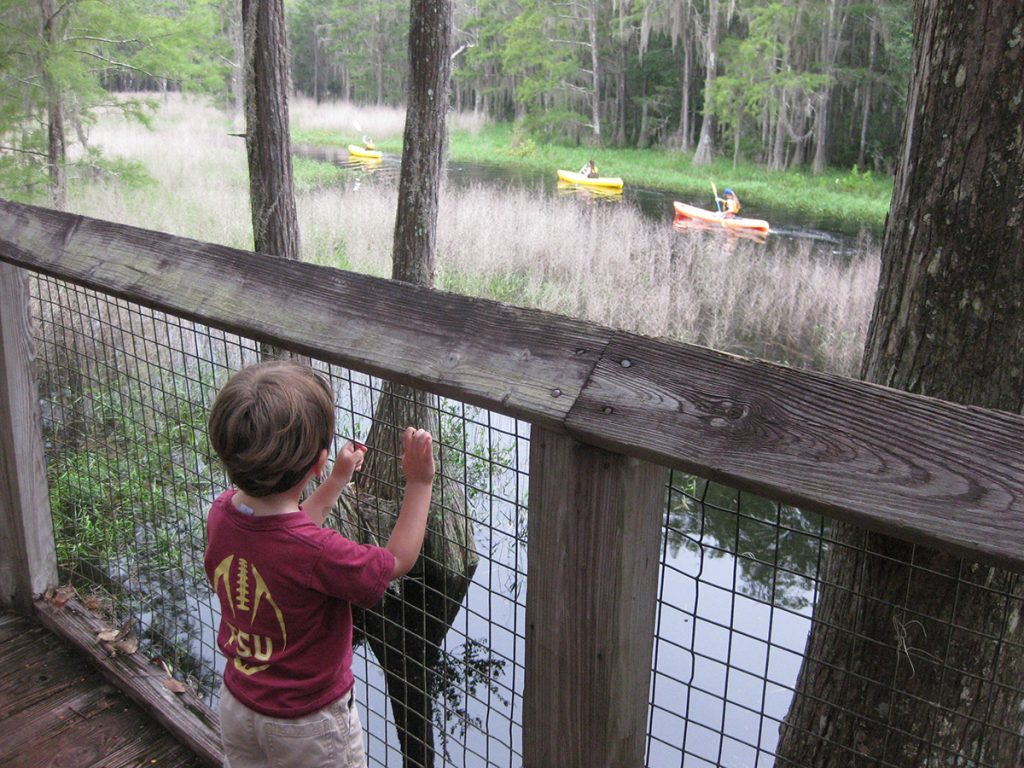
Bradford Brooke Chain of Lakes at a Glance
- Lake Bradford covers 179 acres, Hiawatha 51 acres, and Cascade 124 acres. The Bradford Brook watershed drains a basin of 17,637 acres.
- When the water is high enough, you can kayak or canoe between Lakes Bradford and Hiawatha, and up to the Florida panther enclosure at the Tallahassee Museum.
Read the full Leon County water quality reports for Lake Bradford, Lake Hiawatha, and Lake Cascade.
3. Lake Munson & the Munson Slough System
The Munson Slough system drains the south of Tallahassee, including heavily paved areas such as Florida State University, Florida A&M University, and downtown Tallahassee. A network of canals, pipes, and creeks from Cascades Park to Capital Circle Southwest drains into Munson Slough, which itself drains into Lake Munson. Munson Slough then continues out of Lake Munson, draining into the Floridan Aquifer at Ames Sink. That water emerges from Wakulla Spring within a couple of weeks.
Lake Munson
Nutrients (FDEP Criteria for Clear Water, High Alkalinity Lake)
Chlorophyll-a threshold: 20.0 micrograms (μg)/ Liter (11.1 in 2019)
Total nitrogen threshold: 1.05-1.91 milligrams (mg)/L (.52 in 2019)
Total phosphorous threshold: .03-.09 mg/L (.11 in 2019)
After regularly exceeding Chlorophyll-a and total nitrogen limits between 2012 and 2016, both have met FDEP criteria in samplings since then. Leon County attributes this to a reduction in nutrients flowing in from upstream, and a re-established aquatic plant community. Total phosphorus, on the other hand, has regularly exceeded limits since sampling began in 2004.
Metals
The county found elevated lead levels at two sampling stations in 2019.
Lake Munson Lake Fish Advisory
The Florida Department of Health recommends limits for fish consumption based on mercury levels in Lake Munson:
- Bluegill, brown bullhead catfish, redear sunfish, and white catfish: Twice a week.
- Largemouth bass: Two per week, and once a week for pregnant women and small children.
Florida DOH had once listed polychlorinated biphenyls (PCB) as a contaminant for Lake Munson, but has not in its most recent advisories. However, sediment testing conducted in 2018 showed concentrations of PCBs, arsenic, barium, and dieldrin exceeding residential or commercial standards. PCBs were once used as coolants in electrical equipment, and were likely introduced into Lake Munson when the city would dump transformers into the lake (back when the Edison was a power station). PCBs have been linked to developmental issues in fetuses and children, and cancer.
Lake Elberta and Lake Henrietta
Neither Lake Henrietta or Lake Elberta are sampled. While these lakes have become two of Tallahassee’s top wildlife hotspots, they’re a part of our stormwater infrastructure. Lake Henrietta is situated along Munson Slough, just a few miles north of Lake Munson. Lake Elberta is a retention pond connected to a network of canals and pipes which includes Cascades Park, and which flows into Munson Slough just upstream of Lake Henrietta.

These water bodies were created to collect and filter stormwater making its way into Lake Munson, and ultimately Wakulla Spring. So while we may see garbage and algae blooms in these lakes, the idea is that the problems stay there and not flow downstream. And sampling does show a reduction in nutrients heading down Munson Slough and into Lake Munson in recent years.
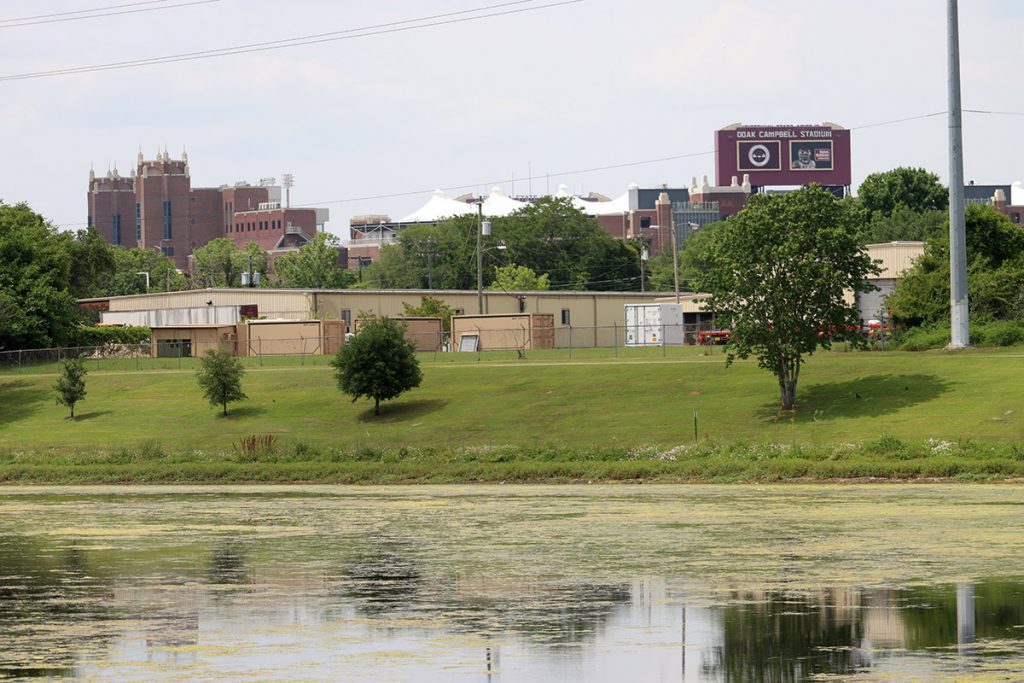
Despite their origins, these parks have value beyond stormwater management. Both are popular recreational spots, and an urban oasis for a wealth of bird species.
Because of this, there are people looking to reduce garbage and nutrients at their source, before they enter these water bodies. Apalachee Audubon Society commissioned a study looking at the source of Lake Elberta’s garbage problem, and ways to reduce it. WFSU’s 2021 Age of Nature intern, Chloe Thompson, wrote about the study early May 2021.
